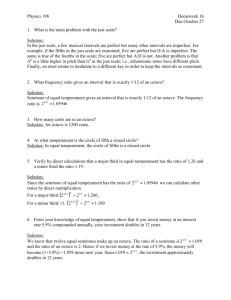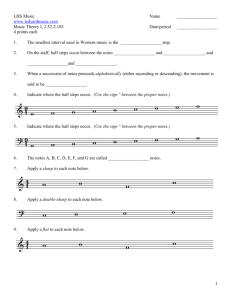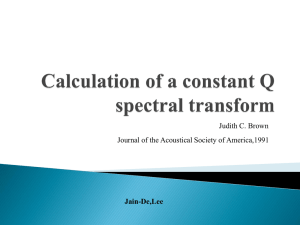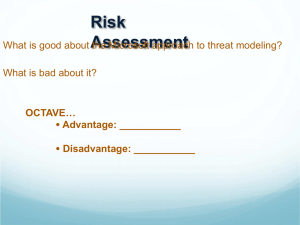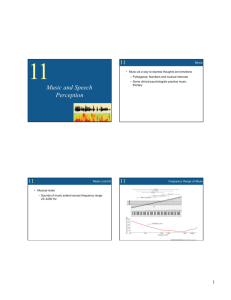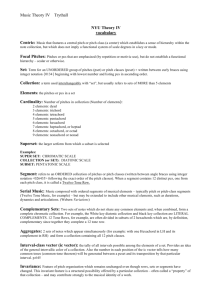SCIENCE, MATHEMATICS AND MUSIC
advertisement
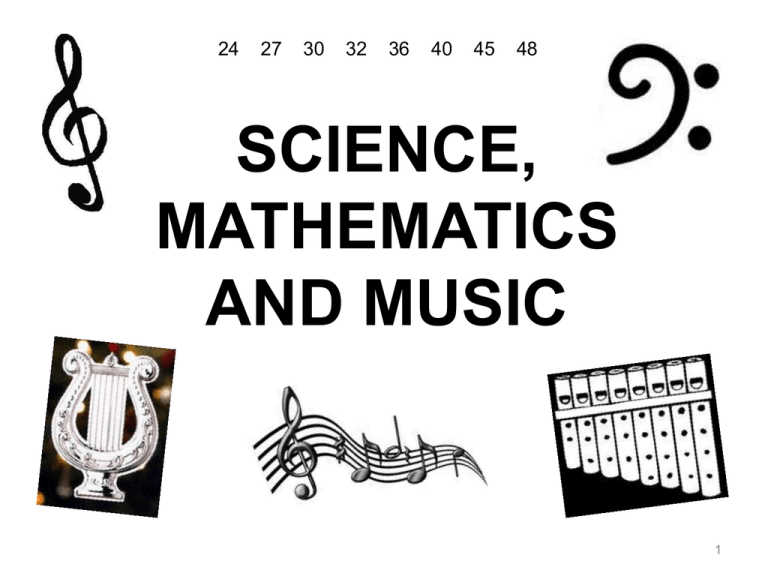
24 27 30 32 36 40 45 48 SCIENCE, MATHEMATICS AND MUSIC 1 Poetry and Music Poetry and music are historically related – chants, songs, incantations Dance and music similarly related Early musical accompaniment for song and dance – Drums Pipes Lyre Lute-like instruments Harp 2 Poetry / Music relationships Poetry Music Rhyme Cadence – repetition of phrase ‘shape’ Rhythm – metre Beat / accent / time signature Mood Modes, major / minor keys Intonation Melody Euphony – pleasant sound Harmony 3 Sound Production Vibrators include – larynx, reeds, lips, edges, strings, membranes, hollow shapes Resonators include body cavities (chest, pharynx, sinuses) boards, pipes, hollow shapes, instrument casing Methods include – blowing (physical or mechanical) plucking, striking, shaking, stroking 4 Musical Instruments – Wind Blowing Voice – larynx and resonance larynx, little resonance Lips trombone trumpet french horn saxophone Reed oboe panpipe basset horn reeds ocarina 5 Wind instruments continued . . . Pumping concertina organ 6 Percussion and striking triangle tambourine castanets kettle drum xylophone 7 Strings – plucking . . . . . . . . . and bowing lyre harp (violon) cello harpsichord guitar violin 8 9 Scan original 10 Human audible range from about 16hz to 25/30,000 (upper end lost with age). i.e. about c-4 to c6 / c7 Concert grand only C -3 33 C -2 66 C -1 132 C 1 (c) 528 C0 264 C2 (c) 1056 C3 (c) 2112 C4 (c) 4224 - Hertz A 27.5 A 440 11 An Aside on Poetic Rhythm Like music, traditional poetry is based on a pattern of stressed / unstressed ‘beats’ – in poetry the beats are syllables and the basic unit is a poetic ‘foot’. There are four main types and one variant :iamb (‘lame’) / ___ / ___ / ___ / ___ / ___ The curfew tolls the knell of parting day ___ / ___ / ___ / ___ / trochee (‘running’) Tyger, tyger, burning bright ___ / / ___ / / ___ / / ___ / / dactyl (‘finger’) I galloped, Dirk galloped, we galloped all three anapest (‘reversed’) / / ___ / / ___ / / ___ / / ___ The Assyrian came down like the wolf on the fold spondee, inserted into iamb ___ ___ to indicate heaviness or weariness The long day wanes, the slow moon climbs 12 These feet are assembled into lines, generally of two to seven feet, known as dimeter, trimeter, tetrameter, pentameter, hexameter, heptameter Shakespeare’s plays and Gray’s famous elegy owe their stately rhythm to their iambic pentameters It’s not always easy to distinguish between iambs and trochees or dactyls and anapests when there are extra or missing syllables at the beginning or end of the line – part of ‘poetic licence’. (Tyger, tyger’ is not a classic trochee as it’s lacking the last syllable) 13 Hymn metres The metres for hymns, to be sung, are identical to those for other poetry, but in order to enable a suitable choice of tunes they are classified by the number of lines per verse (occasionally augmented by the type of foot). Short metre (S.M.) 6.6.8.6. (Blest are the pure in heart) Common metre (C.M.) 8.6.8.6. (Through all the changing scenes of life) Long metre (L.M.) 8.8.8.8. (Forth in thy name O Lord I go) 8.7.8.7.D (the D indicates the metre is doubled, i.e. 8 lines) (Glorious things of thee are spoken) Many others, including ‘irregular’ – usually with a specifically-written tune (O come all ye faithful) 14 Note Lengths The system of note lengths in music is binary, each successive denomination being twice or half the preceding one. Two obsolete long notes are included for illustration – they also explain why ‘breve’ (= short) was used for what is now a rarely used long note. Most modern usage takes the crotchet as the unit of note length and the illustration shows the number of crotchets equal to the long notes or the number of short notes equal to a crotchet. Maxima (25) 32 x Semibreve 4x (22) Quaver = (2-1) 2x Demisemiquaver 8 x = Longa 16 x (24) Breve 8x Minim 2x (21) Crotchet (20) Semiquaver 4 x (2-3) = Hemidemisemiquaver (23) (2-2) 16 x = (2-4) Maxima is 512 (29) times h.d.s.quaver and semibreve is 64 (26) times. Some composers have used even shorter notes, the semi, demi, hemi cycle is then repeated! 15 Modifications to Note Lengths Addition of a dot after a note extends its duration by a half. A second dot adds another quarter, thus:- = . . = Staccato shortens a note by about a half and staccatissimo by about three-quarters. These are indicated by a dot or hyphen respectively below the note, e.g. = = . 16 Tempo The note values do not indicate the actual speed of performance. This is shown either by the appropriate Italian term for the desired speed, or by metronome marks, or sometimes both. Term Prestissimo Presto Allegro Moderato Andante Adagio Larghetto Largo Beats per minute 200-208 168-200 eg 120-168 108-120 eg 76-108 66-76 60-66 eg 40-60 = 176 = 110 = 60 17 Rhythm in Music Like poetry, musical rhythm is based on pattern of stressed/unstressed ‘beats’, arranged mainly in 2’s, 3’s or 4’s. A few composers have experimented with 5’s, 7’s, etc but they are difficult to sing and even more so to dance (the two originators of music). Feet in poetry correspond to bars in music – thus iamb / trochee = duple or quadruple time dactyl / anapest = triple time ‘Time signatures’ combine the number of beats in a bar (numerator) with a measure of beat length (denominator). Crotchets and quavers are the most used denominators but do not indicate actual speed of performance this is governed by TEMPO. 18 March . Minuet Waltz Polka Tango 19 Pitch To the human ear, pitch is observed as ‘highness’ or ‘lowness’ Scientifically, frequency of vibration measured in hertz – vibrations per second Pitch standards are usually related to ‘middle’ C or the A above Three medieval pitches – Domestic (virginals), Church (higher than domestic), Military (higher still). Baroque pitch about A = 415 Handel’s tuning fork A = 422.5 Mozart’s piano about A = 421-422 Military pitch A = 452.5 – means military band could not play with orchestra, piano or choir Philosophical/Scientific pitch C = 256 because repeatedly divisible by 2 A = 426.66 Modern International Standard C = 264, A = 440 Often pressure to raise pitch further, resisted by singers and players of string instruments – more stress ‘Concert pitch’ has no specific meaning – just ‘higher than normal’, whatever normal may be All pitches are approximate and vary with temperature 20 The Diatonic Scale (Greek = through the tones) Discovery usually attributed to Pythagoras – experimenting with strings Earlier civilisations may have been aware – tuning harps, arranging holes in pipes etc Pleasant ‘intervals’ between notes appear to have simple ratios of string length under given tension Later realisation that pitch is a function of tension and length, and of ‘effective’ length in pipes Early trumpet-like instruments sometimes up to three metres long for lower pitch – until discovery of method for bending metal tubes without crushing – Renaissance in 14th century The Diatonic scale provides the basis for Just or Pythagorean Temperament tuning 21 Pythagoras’s Experiment 22 Harmonics ‘Echo’ notes produced by partial vibrations of strings or pipes at higher frequencies Higher or lower notes that give pleasing effects in combination with fundamental (Increasing tension also produces change in pitch but is more relevant to tuning) Simple harmonics in combination produce chords, satisfying ‘filled in’ sound. Agreeable harmonics have simple ratios to fundamental frequency – 2’s, 3’s and 5’s and combinations (6, 8, 15 etc) 7’s, 11’s, 13’s not agreeable! Doubling the frequency gives effect to the human ear of ‘same note but higher’ – doh to doh, soh to soh etc – the octave Taking diatonic sequence of 24, 27 ------------ 48, International standard pitch uses multiple of 11, i.e. 24 x 11 = 264 (middle C) 40 x 11 = 440 (A used for tuning orchestras) Examples of harmonics follow . . . . 23 Natural and ‘Stopped’ Harmonics Base note C = 24 4th natural harmonic 5 times frequency of base note 1/5 E” = 120 1st natural harmonic, twice frequency of the base note ½ C’ = 48 Stopped harmonic – stopped at ¼ string/pipe length 4/3 times base note, with harmonic 4 times base note 2nd natural harmonic 3 times frequency of base note 1/3 G’ = 72 C” = 96 F = 32 24 More about Harmonics Higher harmonics (integer multiples of base frequency) give most notes of Diatonic scale (oddly, except A). Taking base as 24 and reducing all harmonics to 1st octave:- Harmonic Frequency Reduce to 1st Octave Note 1st 24 24 C (doh) nd 2 48 ÷ 2 = 24 C )1st octave) 3rd 72 ÷ 2 = 36 G (soh) th 4 96 ÷ 2 = 24 [sic] 48? C (2nd octave) 5th 120 ÷ 4 = 30 E (mi) 6th 144 ÷ 4 = 36 G (soh again) th 7 168 ÷ 4 = 42 A♯ Bb ?? 8th 192 ÷ 8 = 24 C (3rd octave) 9th 216 ÷ 8 = 27 D (re) th 10 240 ÷ 8 = 30 E again 11th 264 ÷ 8 = 33 below F♯ ?? th 12 288 ÷ 8 = 36 G again 13th 312 ÷ 8 = 39 between Ab & A ?? 14th 336 ÷ 8 = 42 Like 7th harmonic? 15th 360 ÷ 8 = 45 B (te) 16th 384 ÷ 16 = 24 C (4th octave) Most others are unpleasant (?? above) except 18th = D, 20th = E, 24th = G 27th gives 40.5, discordant A in C major, perfect soh in D major (= 1½ x 27) 25 Harmonics of Diatonic Scale 24 27 30 doh re C D mi E 32 36 40 fah soh lah F G A 45 48 te B 60 72 96 frequency Tonic sol-fa doh C’ D’ E’ F’ 192 Relative G’ A’ B’ C’’ C’’’ etc Principal note 26 Mode, Key, Modulation and Temperament Modes used for church music in Middle Ages for variation in mood – joy, sadness, repentance. Modes use different starting notes but remain on the ‘white notes’ of the keyboard Four Ambrosian modes start on D, E, F, G Gregorian additions on C, A, B Glarus added modes for five intermediate semitones – eventually 12 modes in all. The Ambrosian and Gregorian are most widely used:C Hypolydian Mode VI (Gregorian) D Dorian Mode III (Ambrosian) E Phrygian Mode III (Ambrosian – not well liked) F Lydian Mode V (Ambrosian) G Mixolydian Mode VII (Ambrosian) A Hypodorian Mode II ((Gregorian) B Hypophrygian Mode IV (Gregorian (D) An additional Hypomixolydian Mode VIII, also not favoured Modes are still occasionally used in modern music – Vaughan Williams used them in some works Best known example is ‘Greensleeves’ (Hypodorian) though it has a final ‘te-doh’ cadence, so it ends in A minor 27 Keys Early music based on C major (as we know it), Modes simply used different start/finish notes, occasionally with final semitone cadence (te-doh) Late 15th/early 16th century composers (eg Palestrina, Byrd) began to use various starting notes but with diatonic intervals preserved (they are distorted in modes except Hypolydian Mode VI) Thus for starting note G, we need F♯, for start on F we need B , and for E we need F ♯, G ♯, C ♯, D ♯ Nowadays music that stays strictly in one key is considered boring – key shift = Modulation – introduces accidentals - ♯ and b By the Bach era modulation was standard and chromatics (shifting in semitones) entered the musical armoury. It became apparent that instruments tuned to diatonic intervals in a particular key produced unpleasant clashes when modulating to certain other keys. These dissonances became known as ‘the wolf’ – they bite your ears! The ‘wolf’ can also occur with inadequately designed instruments when the natural harmonic of the resonator (violin body, wind instrument tube, keyboard casing etc) clashes with the harmonics of the note being played – like a glass jangling when a certain note is played! 28 Comparison of Keys (major, minor) and Modes 29 ‘The Wolf’ For most human ears, the lower limit of perception of change in pitch is about one tenth to one eighth of a tone, corresponding to 1% to 1½% in frequency. For a dissonance in a chord the threshold may be lower. The discrepancies from true harmonies in modulation for an instrument tuned diatonically can reach 1.3% - this causes the wolf. As an example, a modulation from C major to F major gives the following relative frequencies: F G A B C D E F 32 36 40 * 48 54 60 64 * B not defined What we require for true diatonics, starting with F, are: F G A B C D E F 32 36 40 42.67 48 53.33 60 64 The D will be noticeably out of tune unless the instrument can be retuned to F as keynote. The discrepancy in D is about 1¼%, and for other keys similar problems occur. 30 Perfect Fifths – The Tuner’s Dilemma The octave and the fifth (C – G, E – B etc) are easy to tune by ear due to their harmonics. A piano or harpsichord tuner would start from one note, say middle C, and tune the upper and lower octaves from it. An obvious next step is to tune the Gs, i.e. the fifths from each C, with a check on the G octaves. From G, the fifths progress via D, A, E, B, then into sharps. Downwards from C, he would tune F, then B, E and on through the flats and even double flats to D When he reaches B♯ upwards & D downwards, he expects to arrive back at C. Tuning in perfect fifths, ratio 3/2 or their inverse, the perfect fourths (4/3), he arrives at B♯ about a quarter-tone sharp of C, and at D about a quarter-tone flat of C. In fact, it happens that only F, G and D have their pure diatonic frequencies, while E, A and B are distorted. Also none of the ‘enharmonics’, like C♯/D , F♯/G , concur. 31 Tuning by Octaves, fifths and fourths (starting Co = middle C) 32 The Problem of Perfect Fifths Mathematically, the problem is that 12 rising fifths correspond closely, but not exactly, to 7 rising octaves. With ratios of 3/2 for the fifth and 2 for the octave, (3/2)12 = 129.746… 27 = 1.28 a discrepancy of 129.746 / 128/000 = 1.01364 or about 1.4%. Thus the relative frequency for B♯ becomes 24 x 1.01364 = 24.33 and for D becomes 24 x 1.01364 = 23.67 33 The Modulation Problem (Diatonic Scale) The Diatonic scale gives specific ratios between the frequencies of successive notes – five whole tones and two semi-tones. However the whole tones vary between 9/8 and 10/9, as shown below for the key of C major. Unfortunately, even a change to a closely related key such as from C to G or C to F distorts these ratios. In the diagram _ indicates that the ratio is not determined until :* a new semitone is introduced If we set F♯ and Bb to the frequencies required for the G major and F major keys respectively, it turns out that they are not suitable for many of the more remote keys C major. C _____ D ______ E ______ F ______ G ______ A ______ B ______C 9/8 10/9 16/15 9/8 10/9 9/8 16/15 G major G ______ A ______ B ______ C ______ D ______ E ______ F ______ G 10/9 9/8 16/15 9/8 10/9 _ _ * F major F ______ G ______ A ______ B ______ C ______ D ______ E ______ F 9/8 10/9 _ * _ 9/8 10/9 16/15 34 More Problems with Modulation The modulation problem is exacerbated when two or more keys require the same sharps or flats – they may require different tunings for the same apparent note! Although we now think of C♯ being the same as Db, F♯ the same as Gb, etc, this is not strictly true. A comparison of the keys F, D, A, E and B (all major) illustrates the more general problem. NOTE C C♯ / D D D♯ / E E F F♯ / G G G♯ / A A A♯ / B B C C 24 -27 -30 32 -36 -40 -45 48 F 24 -26.6 -30 32 -36 -40 42.6 -48 KEY D -25.31 27 -30.38 -33.75 36 -40.5 -45 -- A -25 26.6 -30 -33.3 -37.5 40 -45 -- E -25 -28.12 30 -33.75 -37.5 40 -45 -- B -25.31 -28.31 30 -33.75 -37.5 -42 45 -35 Killing the Wolf During Bach’s time, musicians experimented with changes in tuning, especially of harpsichords, claviers etc, adjusting the frequency of certain notes to avoid the wolf. This worked well in some closely related keys but made matters worse in others more remote. Bach was known to tweak the tuning of a note on his harpsichord, even during play! Such devices were not appropriate for ‘fixed pitch’ instruments like oboes, flutes, trumpets, organs. Another experiment involved introducing extra strings, eg for pairs of notes like A and B. This obviously became cumbersome – one keyboard experiment had 53 keys within the octave to cope with the 3, 4 or even 5 variants of each note. The most widely adopted approach was Meantone. It retained the perfect fifth on the keynote and also major thirds (C to E, F to A etc) but adjusted the notes in between. There would be a different Meantone for each base key. Meantone tuning allowed acceptable modulation to three sharp or flat major keys and one minor each way. Other keys would still suffer the wolf – even worse than in ‘Just’ Temperament. 36 More about Meantone For meantone centred on C (and again setting C = 24) the following frequencies result. C D E F G A B C 24 26.83 30 32.2 36 40.25 45 48 The sharps / flats would be about halfway between the adjacent whole tones, eg about 25.4 for C♯ / D 38.1 for A♯ / B etc. In Meantone C, acceptable modulation to G, D or A (on the sharp side) or F, B and E on the flat side. A and D minors were also satisfactory. More remote keys (B, F♯, D etc) would become discordant. The comparison between Meantone C and Just Temperament can be illustrated thus, on a logarithmic scale. Just Temperament (Diatonic) C D E F G A B C |________|________|____|_________|________|__________|_____| C D E F G Meantone C A B C 37 Equal Temperament The principle of Equal Temperament, with all semitone ratios equal, was certainly known to the Greeks and possibly earlier. Some writings of Aristoxenos (c350 BC, a student of Aristotle) are preserved and demonstrate this. We require twelve equal semitone ratios within the octave. With a 2:1 ratio in frequency for the octave, this means the semitone must become 2 1/12th .Using a computer or modern calculator, or by logarithms, this is easily evaluated as 1.059463…… Although the Greeks did not have these methods available, their skill with fractions would enable them to solve the problem thus:We know that 16/15 is too large (raised to the 12th power it is 2.1694….. (about 2 1/6th). 17/16 is also too large (2.07 approx), but 18/17 is slightly too small (1.9856 approx). By interpolation, we find 178/168 is close enough (2.001376) and this reduces to 89/84, or 1.059524 in decimal notation. Applying this ratio twelve times yields the ‘well tempered’ or Equal Temperament chromatic scale. For most people, the discrepancies from ‘Just Temperament’ (the Diatonic scale) are not noticeable of objectionable. Although some purists prefer Just or Meantone for early music played on period instruments, for most listeners they sound a little strange. 38 The Equal Temperament Scale Twelve equal semitone ratios in the octave. Frequency ratio 2 1/12th = 1.0595 Close to 89/84 instead of 16/15 for the diatonic semitone. All notes are slightly distorted except the octave. None of the discrepancies offensive and most listeners unaware of them. Permits free modulation among all keys without the wolf. Sharp and adjacent flat semitones are merged – C♯/D , D ♯ /E , F♯ /G , G ♯ /A , A♯ /B (enharmonics) The whole tone becomes 1.1225 (449/400) instead of 1.125 or 1.111 (9/8 or 10/9) For base note 24, the other notes become:C C♯/D D D♯/E E F F♯/G 24.00 24 25.43 26.94 27 G G♯/A A A♯/B B C 28.54 30.24 32.04 33.94 35.96 38.10 40.36 42.76 45.31 48 compared with the diatonic 30 32 36 40 45 48 39 Comparisons of Just, Meantone and Equal Temperaments (logarithmic scaling) For Just and Meantone temperaments, ♯ and semitones vary within shaded bands. For Equal Temperament, all semitone intervals are in the same ratio (1.0595) 40 Other Musical Scales Numerous musical scales have been used at various times and by differen cultures. Chinese and other Oriental music has a tradition of the Pentatonic scale, represented by C D E G A C in Western notation. (Note that the diatonic semitones (F, B) are missing). C D E G A C Another Pentatonic scale with equal intervals has the three versions, based on minor thirds:C Eb F♯ A C C♯ E G Bb C♯ D Ab F B D The chord based on these five notes is often used in Western music, resolving onto a major or minor triad. The whole tone is hexatonic, in two versions:C D E F♯ G♯ A♯ C C♯ D♯ F G A B C♯ 41 Other Musical Scales (continued) The chromatic scale reappears in 20th century music as the Twelve Note scale. The difference is that instead of the semitone being used for embellishment or modulation, all notes are treated as equally important – in other words there are no major or minor keys as such. Microtone scales use intervals of less than a semitone. Some Asian music uses quarter-tones and a few composers have experimented with one-eighth tones. They need to be played on unfretted strings, wind instruments with a slide (trombones) or produced electronically. Like many of the other variant scales, they do not appeal to Western ears versed in the Diatonic or Equal Temperament tradition. Finally, there is the Bagpipe scale. This scale, unique to traditional Scottish music, has a ‘drone’ note played continuously, plus just over an octave (G to A) of almost conventional notes, except that the C and F are slightly sharp of true diatonic tuning. 42 ‘Twinkle, Twinkle, Little Star’ in other musical scales 43 Thank you – any questions? 44
